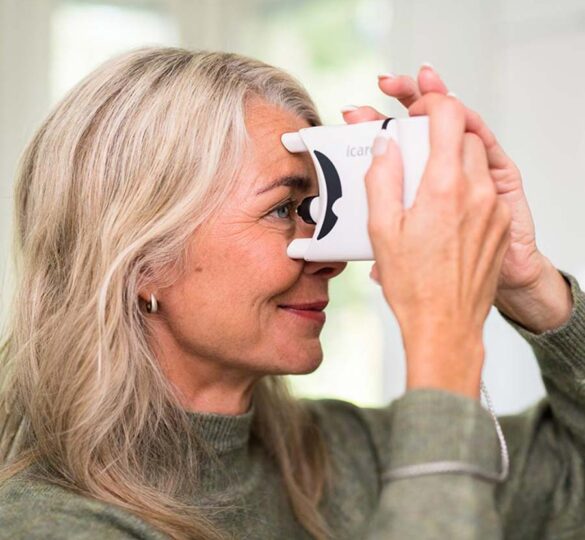Home IOP Measurements: What they can tell us
Understanding how your IOP changes over time can help you and your doctor feel confident that your glaucoma treatment is working effectively.

Why is Monitoring IOP Important?
IOP (intraocular pressure) is the key risk factor for glaucoma development and progression. We know that IOP fluctuates constantly, between doctor’s visits, with exercise, during sleep, and even throughout the day. Very much like blood pressure and glucose levels it is helpful to be able to look for “highs and lows.” The more frequently your IOP is measured, the better overall picture your doctor will have of any fluctuations.
Currently, the most common way to get this information is to measure IOP in the clinic at different times of day over several visits. With recent advances, IOP measurements are now possible at home, with an FDA approved prescription device called the iCare® HOME. Current in-office diagnostic techniques provide sufficient information to treat most glaucoma patients but in rare cases, monitoring IOP at home may be helpful.
What is a Home Tonometer Device?
The iCare® HOME tonometer is a prescription device that uses a disposable probe to take six rapid IOP measurements without a numbing drop, then calculates the average IOP and stores it in the device’s memory in the cloud. This device may help to analyze IOP patterns and understand why some glaucoma patients get worse despite good IOP readings in the office.
There are several challenges with using this device and it is not recommended for routine use. Up to 25% of users are not able to successfully measure their IOP with this device. And even those who have been trained and certified to use the device, may get some variations between IOP measurements taken close together. Training videos or assistance from a technician may improve usability.
How do I access the iCare® HOME device?
A patient can’t simply purchase or rent this device, a prescription from your doctor is needed. Most patients do not need home monitoring of IOP. But in the few where it might be helpful, I think it is not necessary to own this device; even a week or two of home IOP monitoring might provide useful information.
We don’t yet fully understand why IOP spikes occur in some people, and how IOP fluctuations affect the eye in the long-term. Even so, it is exciting that this technology is available and further study will help determine how best to use it.
Article by Barbara Wirostko, MD, FARVO. Posted on September 3, 2021 — Last reviewed on March 7, 2022.

Barbara Wirostko, MD, FARVO
Barbara Wirostko, MD, FARVO is an Adjunct Professor of Ophthalmology at the Moran Eye Center and Department of Biomedical Engineering, University of Utah, SLC. She is an entrepreneur and glaucoma specialist serving as Chief Medical Officer of Qlaris Bio and cofounder for MyEyes.net She received her BS with distinction from Cornell University, MD from Columbia Presbyterian College of Physicians and Surgeons, ophthalmology residency training at Columbia, and glaucoma subspecialty training at Cornell Medical Center.